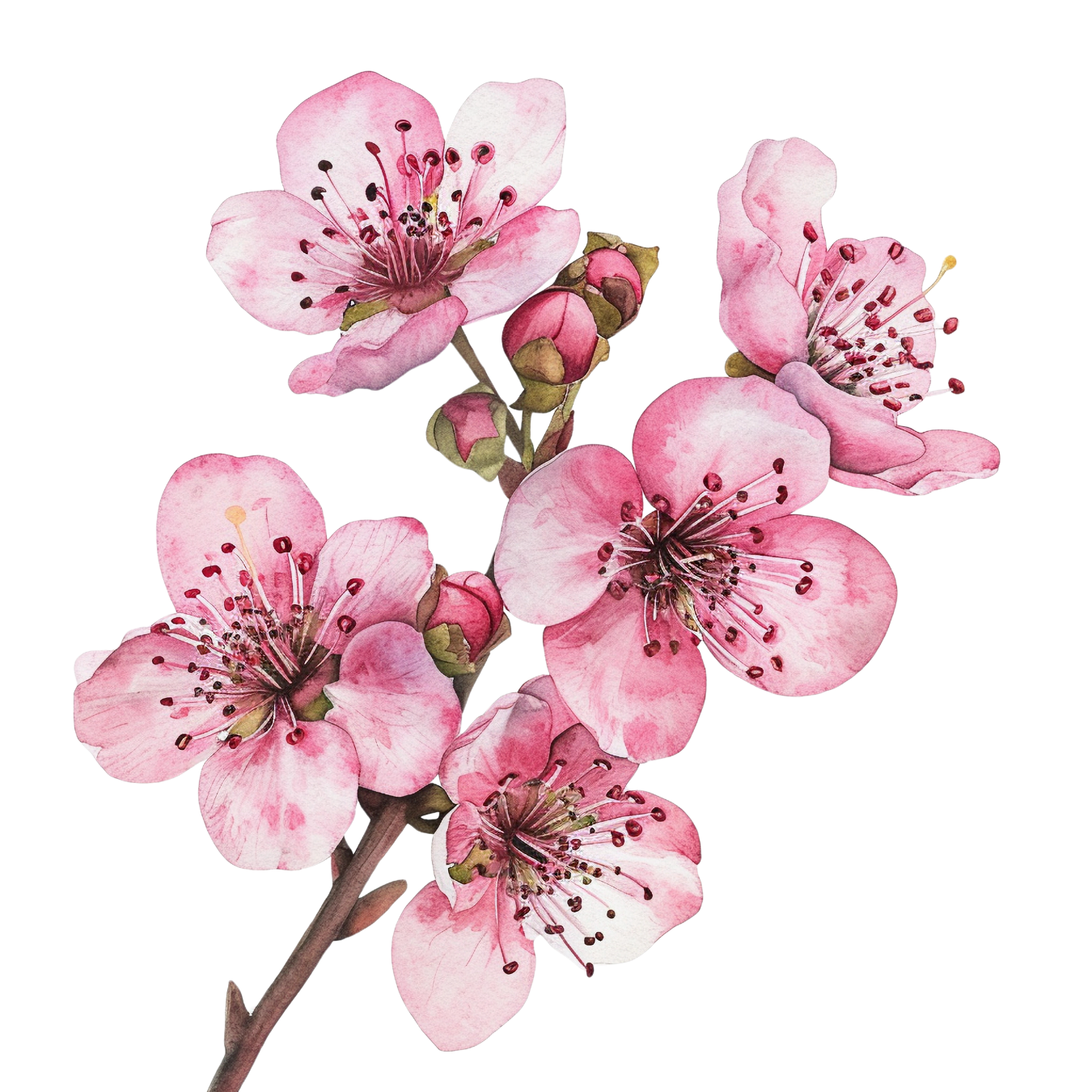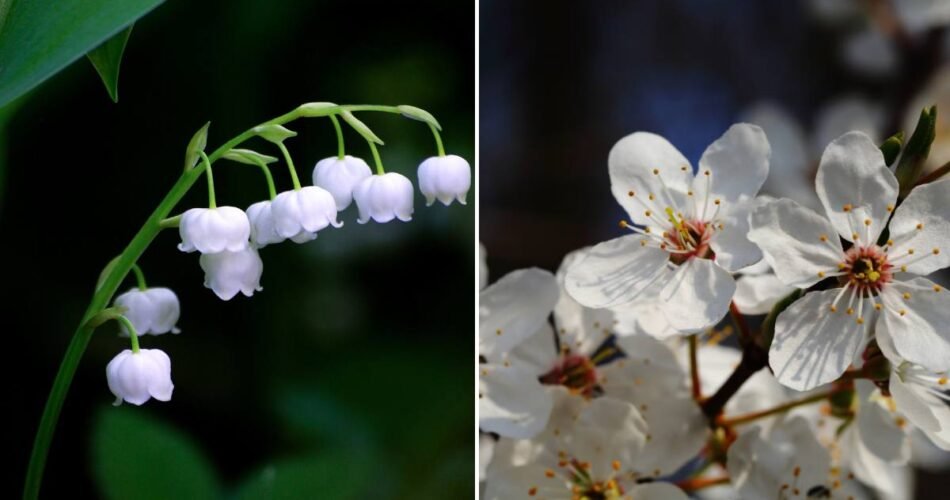What are the May birth flowers?
May celebrates the full swing of spring with two enchanting birth flowers: the Lily of the Valley and the Hawthorn. The Lily of the Valley, with its delicate and fragrant white bells, symbolizes humility, chastity, and the return of happiness. The Hawthorn, on the other hand, represents hope and supreme happiness with its white or pink blossoms. Both flowers embody the rejuvenation and abundance of May, marking a time of growth and renewal in nature.
In this blog post, we will explore the fascinating world of birth month flowers, their meanings, origins, and fascinating facts. We will also explore how these flowers inspire art, creativity, and thoughtful gift ideas. So, let’s embark on this journey and uncover the beauty and meaning of May birth month flowers.
Related Post: Birth Flowers for all 12 months
History & Origin of Lily of the Valley

The Lily of the Valley (Convallaria majalis) is a perennial plant known for its sweet-scented and bell-shaped white flowers. This flower has deep roots in folklore and tradition, often associated with the return of joy and the celebration of spring. According to Christian legend, the Lily of the Valley was said to have formed from the tears of the Virgin Mary during the crucifixion of Jesus, which is why it’s sometimes called “Our Lady’s Tears.”
In addition to its religious significance, the Lily of the Valley has been celebrated in various cultures as a symbol of spring’s arrival. Its connection to May stems from its blooming period, which typically occurs in late April and early May, making it a fitting emblem for the month’s themes of renewal and the blossoming of life.
What does Lily of the Valley mean?
Lily of the Valley carries rich symbolism and is often associated with various positive attributes:
- Humility: Its delicate and unassuming flowers are a symbol of humility, reflecting the virtue of modesty.
- Purity and Chastity: The pure white color of the flowers symbolizes purity and chastity, often linked to the Virgin Mary in Christian symbolism.
- Return of Happiness: The flower’s appearance in spring, a time of renewal, signifies the return of happiness and the promise of new beginnings.
- Good Luck: In some cultures, Lily of the Valley is considered a bringer of good luck and is often used in wedding bouquets for this reason.
How to care for Lily of the Valley
Caring for Lily of the Valley is relatively simple, making it a great addition to shade gardens:
- Shade and Sunlight: Lily of the Valley prefers shaded areas, making it ideal for woodland gardens or shaded borders. It can tolerate morning sun but should be protected from harsh afternoon sunlight.
- Soil Requirements: This plant thrives in well-drained, moist soil that is rich in organic matter. Adding compost or leaf mold can improve soil conditions and support healthy growth.
- Watering: Keep the soil consistently moist, especially during dry periods. However, avoid waterlogging as this can lead to root rot.
- Spreading: Lily of the Valley is a spreading plant and can form dense colonies once established. Consider this growth habit when choosing a planting location to prevent it from overtaking other plants.
- Aftercare: After the flowers have bloomed, allow the foliage to remain until it turns yellow and dies back naturally. This process helps the plant store energy for the next year’s flowering.
Interesting or less known facts about Lily of the Valley
- Royal Favor: Lily of the Valley is a favorite in royal gardens and bouquets. It was famously included in the wedding bouquet of Queen Victoria and has been used in several royal weddings since, including that of Grace Kelly and Prince Rainier III of Monaco.
- May Day Tradition: In France, it’s a tradition on May 1st, known as La Fête du Muguet, to give loved ones small bouquets of Lily of the Valley as a token of luck and happiness.
- Toxic Beauty: Despite its delicate appearance and sweet fragrance, Lily of the Valley is highly toxic if ingested, containing cardiac glycosides that can cause serious health issues.
- Musical Inspiration: The flower has inspired not only poets and writers but also composers. The “Waltz of the Flowers” from Tchaikovsky’s The Nutcracker is said to have been inspired by the enchanting bells of the Lily of the Valley.
History & Origin of Hawthorn

The Hawthorn (Crataegus species), with its dense branches and delicate blossoms, has a history steeped in folklore and myth. Known for its hardiness, the Hawthorn is native to temperate regions of Europe, North America, and Asia. Its association with May comes from its blooming period, where in many parts of the world, it’s one of the first trees to flower in late spring, heralding the strength and beauty of the season.
Hawthorn has been a symbol of hope and protection for centuries. In Celtic mythology, it’s considered a sacred tree, believed to house fairies and spirits. The tree’s dense thorny branches were also thought to protect against evil spirits, leading to its common planting near homes and in hedges. Its connection to May is not only due to its blooming cycle but also to its symbolic representation of fertility and growth, aligning with the themes of renewal and life that the month of May embodies.
What does Hawthorn mean?
Hawthorn, with its dense branches adorned with delicate blossoms, carries deep symbolism across various cultures:
- Hope and Protection: Historically, Hawthorn has been a symbol of hope and protection. Its dense, thorny branches were believed to protect against negative energies and malevolent spirits.
- Fertility and Growth: Blooming in May, the Hawthorn is also associated with fertility and growth, celebrating the renewal of life and the abundance of spring.
- Love and Marriage: In some traditions, Hawthorn blossoms are used in wedding decorations and ceremonies, symbolizing love, unity, and the promise of a fruitful union.
How to care for Hawthorn
Hawthorn trees are hardy and resilient, making them relatively easy to care for while providing beauty and charm to any garden:
- Soil Requirements: Hawthorn trees are adaptable to a wide range of soil conditions but prefer well-drained soil. They can thrive in both acidic and alkaline pH levels.
- Sunlight: These trees do best in full sun but can tolerate partial shade. Full sun encourages the most abundant flowering.
- Watering: While Hawthorn trees are drought-tolerant once established, regular watering during their first few growing seasons helps to establish a strong root system. Water deeply, especially during dry spells.
- Pruning: Prune Hawthorn trees in late winter or early spring to remove dead or crossing branches and to maintain their shape. This also helps to prevent disease by improving air circulation.
- Fertilization: Apply a balanced fertilizer in the early spring to support healthy growth and flowering. However, avoid over-fertilizing, as Hawthorn trees generally require minimal additional nutrients.
Interesting or less known facts about Hawthorn
- Ancient Medicine: Hawthorn has been used in traditional medicine for centuries, particularly for heart health. Its leaves, flowers, and berries are believed to strengthen the cardiovascular system.
- Fairy Tree: In Celtic folklore, Hawthorn trees are considered sacred and are often referred to as “Fairy Trees.” It was believed that fairies lived under these trees, and disturbing a Hawthorn tree could bring bad luck.
- Crown of Thorns: Some legends suggest that the crown of thorns placed on Jesus’s head at his crucifixion was made from Hawthorn branches, linking the tree to themes of sacrifice and salvation.
- Diverse Species: There are over 200 species of Hawthorn, each with its unique characteristics. Some species grow as small shrubs, while others can become towering trees.
May Birth Flower Comparison
| Month | Birth Flower | Characteristics | Symbolism |
|---|---|---|---|
| May | Lily of the Valley | Tiny bell-shaped flowers, sweet scent | Humility, chastity, sweetness |
Hawthorn | Small, white to pink flowers, grows as a bush or tree | Hope, supreme happiness, fertility |
What are the popular May birth flower gifts?
The elegant Lily of the Valley and the charming Hawthorn inspire a variety of heartfelt gifts for May celebrations:
- Fragrant Bouquets: A bouquet featuring the sweet-smelling Lily of the Valley or the delicate blossoms of Hawthorn makes a thoughtful and fragrant gift.
- Potted Plants: Gifting a potted Lily of the Valley or a young Hawthorn tree can offer the recipient a lasting piece of natural beauty to cultivate and enjoy.
- Artisanal Soaps and Perfumes: Products infused with the scent of Lily of the Valley capture the essence of May in a luxurious form, perfect for pampering.
- Jewelry: Delicate pieces of jewelry inspired by the Lily of the Valley or Hawthorn blossoms, such as necklaces or brooches, make for elegant and meaningful gifts.
- Prints and Artwork: Artistic renditions of May’s birth flowers in watercolor prints, illustrations, or photographs can add a touch of springtime charm to any space.
Here are some more gift ideas featuring May’s birth flowers to explore.








What are some artistic or creative applications of May birth flower?
The enchanting Lily of the Valley and Hawthorn offer endless inspiration for artistic and creative endeavors:
- Floral Design: Incorporate these flowers into intricate floral designs and arrangements, perfect for special occasions and sprucing up home decor.
- Botanical Illustration: Lily of the Valley and Hawthorn are popular subjects for botanical illustration, capturing their delicate details in art pieces that celebrate the beauty of nature.
- Fashion and Accessories: These flowers can be stylized into elegant patterns for scarves, bags, and other fashion accessories, adding a touch of spring’s charm to any outfit.
- Tattoo Art: For a more permanent tribute, tattoos featuring the delicate bells of Lily of the Valley or the blossoms of Hawthorn can symbolize purity, hope, and the renewal that comes with spring.
Conclusion
May’s birth flowers, the Lily of the Valley and Hawthorn, are not just harbingers of spring but also symbols of renewal, hope, and the joy of life. Their delicate beauty and deep symbolism offer a reminder to cherish the fleeting moments of beauty and to embrace the new beginnings that each spring brings. Whether celebrated through gardening, gifted in bouquets, or immortalized in art and tattoos, these flowers encourage us to appreciate the natural world and the cycle of life it represents.
10 FAQs
What are the birth flowers for May?
Lily of the Valley and Hawthorn.
What does the Lily of the Valley symbolize?
Purity, humility, and the return of happiness.
What is the significance of Hawthorn?
Hope, protection, and happiness.
Are Lily of the Valley flowers toxic?
Yes, all parts of the plant are toxic if ingested.
Can Hawthorn be used for medicinal purposes?
Yes, particularly for heart-related conditions, but always consult with a healthcare provider first.
How should I care for potted Lily of the Valley?
Keep it in partial shade with moist, well-draining soil.
Is it easy to grow Hawthorn?
Yes, Hawthorn is hardy and adaptable to various conditions.
When do Lily of the Valley flowers bloom?
Typically in late April to May.
Can I use Hawthorn berries in cooking?
Yes, but ensure they are correctly identified and prepared safely.
Are there different varieties of Lily of the Valley and Hawthorn?
Yes, there are several cultivars of each, offering variations in appearance and size.

